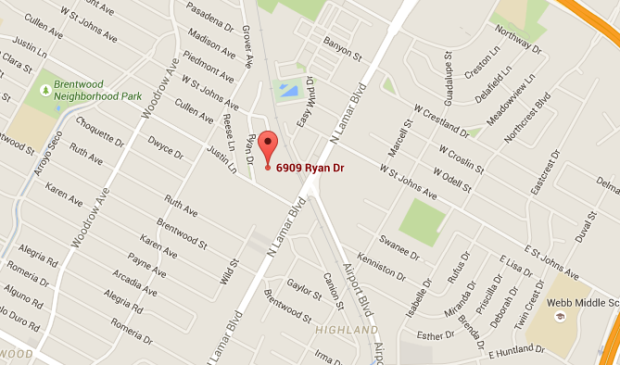Crestview park could be on the way
Thursday, July 9, 2015 by
Jack Craver Crestview Neighborhood activists may finally get the new park they’ve wanted for years. Austin Energy is currently in the process of finding a new storage site so that one of its current properties, at 6909 Ryan Drive, can be converted into parkland or a combination of parkland and housing.
City Council Member Leslie Pool, who campaigned last year in support of turning the parcel into a park, said she is pleased by how quickly the process has evolved in the park plan’s favor since her election to Council in November.
“(T)he inertia seems to have dissolved, ideas are in motion and I’m doing what I can from my perspective to help get a park for Crestview,” she said. Pool nevertheless emphasized that the planning is in the preliminary stages and that it is hard to say when the final plan will be realized.
The first step will be finding a new location for the current storage facility, a process that Austin Energy spokesperson Carlos Cordova said has just begun.
“We are actively looking for a new site,” he said. The utility has proposed $500,000 in the 2016 budget and $3.5 million in the 2017 budget to finance purchasing a new property and relocating facilities.
Assuming Austin Energy is able to move, the city still has to come up with funds to buy the Ryan Drive parcel from the utility and develop it into parkland. The most recent appraisal pegged the property value at $5.38 million. Since state law prohibits utilities from selling off property at below fair market value, there’s no hope for the city to get a discount.
Pool envisions a deal in which the city spends roughly $1 million annually for five years to secure the purchase. Then there’s the cost of transforming the property into a park, which remains unclear in the absence of further analysis by the city. The money certainly won’t come easy, Pool concedes, suggesting that the Parks and Recreation Department is underfunded, a problem she hopes to remedy by boosting funding for the agency in the upcoming budget.
“The biggest thing is the cleanup of the site,” said Pool, noting the need to remove any harmful chemicals that might be present as a result of the land’s current use.
Assuming Austin Energy moves, there seems to be little doubt that a park will take up at least part of the property. The surrounding neighborhood has been identified as “park deficient” ever since Council approved a resolution in 2009 that set a goal of having every city resident live within a quarter-mile of a park.
But the push for a new park is competing with an ongoing desire for more affordable housing in the area. Not only have city planners in the past signaled an interest in using the property for housing, but since the Austin Housing Finance Corporation has the right of first refusal on any vacated city property, park advocates may have some negotiating to do.
A possible compromise in the form of mixed-use development of the parcel, to include parkland and housing, was outlined in a December 2014 cost-benefit analysis prepared for Council by Planning and Development Director Greg Guernsey. The memo outlined the pros and cons of two mixed-use alternatives (one denser) as well as the option of converting the entire property into parkland.
The benefits of a mixed-use plan identified by the city include increased tax revenue and the possibility of an agreement with an eventual developer to maintain the parkland that would accompany the housing. Drawbacks included more impervious cover and, of course, a smaller green space that would not accommodate the wide range of programming of a larger park.
Pool hopes the entire property can become a park but said she is exploring opportunities for affordable housing on a neighboring private property owned by developer Peter Barlin. She hopes converting that property into housing would leave the AE property free for a big park.
“I’m very interested in pursuing enlarging the scope of the concept to include the adjacent privately owned parcel as a possibility to achieve both goals,” she said.
Matthew Armstrong, who recently stepped down as president of the Crestview Neighborhood Association, said that he and other park advocates may be willing to accept housing on the property, but insists that the parkland must take up at least 3 1/2 acres of the roughly 5-acre parcel. In exchange for such a compromise, Armstrong suggested that the city provide other amenities long sought by neighbors to slow traffic and facilitate walking, such as stop signs, speed bumps and more pedestrian crossings of nearby railroad tracks.
Armstrong said the neighborhood has been pushing for a park since a rash of development in the area in 2007, including the Midtown Commons townhouses, which sparked concerns from residents that hopes for future green space would be stamped out by nonstop housing construction.
City planners patiently listened to neighbors express hope for creating the park but nevertheless recommended in 2013 that the property be used for housing, a decision that infuriated neighborhood activists but did not result in any action.
Things have changed, said Armstrong, as a result of the new district-based Council members.
“But now we have Leslie Pool, who is our advocate, and we have (Council Member) Greg Casar nearby, who is also working with us,” he said.
Image from Google Maps.
You're a community leader
And we’re honored you look to us for serious, in-depth news. You know a strong community needs local and dedicated watchdog reporting. We’re here for you and that won’t change. Now will you take the powerful next step and support our nonprofit news organization?






